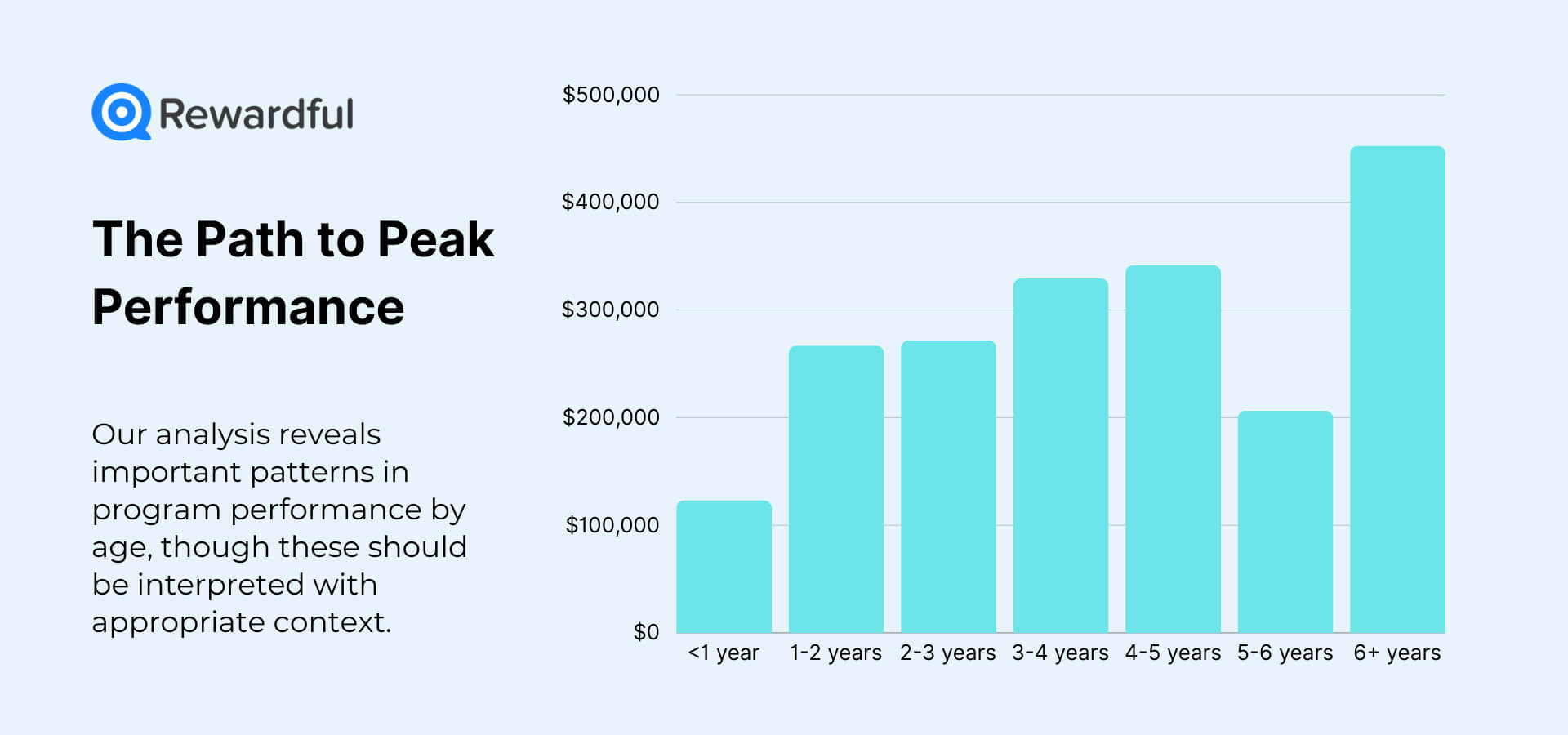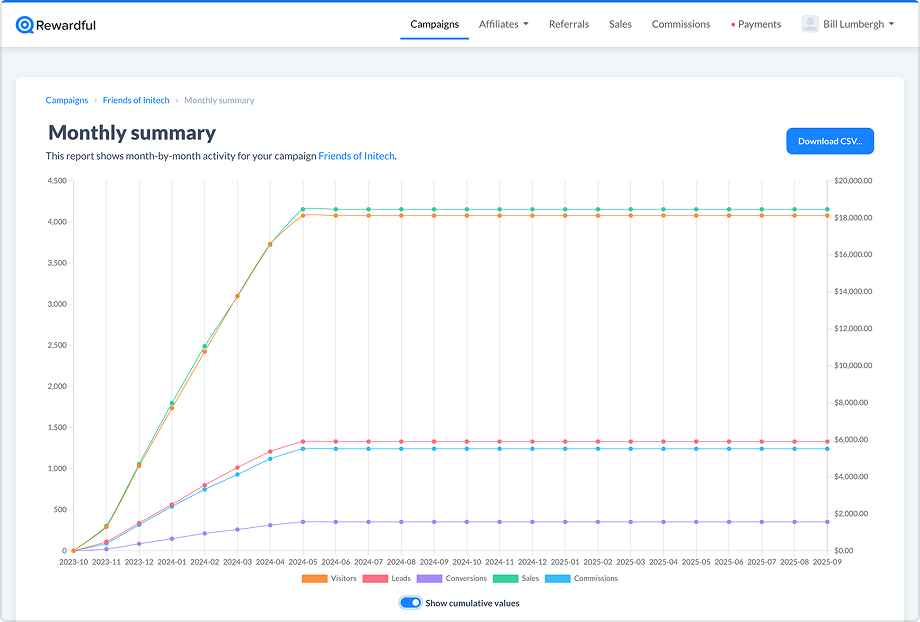SaaS affiliate program benchmarks are becoming important as affiliate marketing programs play a major role in driving revenue for software businesses. Unlike consumer-focused campaigns, SaaS affiliate programs often contribute a significant share of monthly recurring revenue, but how much can companies in different industries realistically expect?
To answer this, we analyzed the performance of various SaaS affiliate programs that collectively generated $68.4 million in revenue over the past 12 months. The analysis goes beyond raw numbers, revealing patterns and trends in affiliate performance across different SaaS niches.
These findings highlight how companies successfully implement SaaS growth strategies and optimize affiliate programs, giving founders and marketing leaders actionable benchmarks to set realistic goals, maximize affiliate ROI, and scale their programs more effectively.
AI and Machine Learning SaaS Affiliate Programs: The Breakout Performer
If there's one sector where affiliate marketing programs are absolutely exploding, it's (you guessed it) AI and machine learning SaaS. The combination of massive market interest, visual demonstration potential, and rapid adoption cycles creates perfect conditions for affiliate success. Companies in this space often leverage SaaS growth strategies that integrate affiliate programs as a core acquisition channel.
Here are the AI SaaS affiliate marketing benchmarks, and some of the top-performing AI affiliate programs for SaaS products.
AI SaaS Affiliate Marketing Benchmarks
- MRR contribution: 15-25% once established (highest across all SaaS sectors)
- Growth trajectory: 3-5x affiliate scaling possible in a quarter
- Affiliate profile: Tech reviewers, productivity content creators, AI enthusiasts
- Content advantage: Visual transformations create high-converting affiliate content
Top-performing AI affiliate programs for SaaS products
HeadshotPro
HeadshotPro uses AI to generate professional-quality headshots. Their affiliate program drives $50k+ in monthly revenue, representing 15% of the company’s total revenue. This program highlights how targeting content creators and professionals with shareable, results-driven AI tools can generate substantial affiliate income.
getimg.ai
getimg.ai is a leading AI image generation platform, processing over 1 million images daily. Their affiliate program accounts for 15–20% of MRR and thrives because affiliates can create visually striking “before/after” content that naturally attracts engagement.
OpusClip
OpusClip repurposes video content with AI, allowing users to create short, engaging clips. Their affiliate program has generated over $100k in total revenue and supports hundreds of active affiliates.
Key Takeaways for Businesses Considering AI SaaS Affiliate Programs
- Products with visual or demonstrable outcomes are easier for affiliates to market.
- Rapid adoption cycles allow for fast scaling of affiliate-driven MRR.
- High-performing programs often provide affiliates with marketing assets and example content to optimize affiliate program performance.
- Benchmark ranges: 15–25% MRR contribution, 3–5x scaling potential in a single quarter.
Content Creator Platform Affiliate Program Benchmarks
SaaS companies serving content creators have discovered a powerful dynamic: their customers often make the best affiliates. When your SaaS software helps people build audiences, create content, or monetize their expertise, those same people become natural advocates.
What makes these affiliate marketing programs particularly effective is the built-in credibility factor—their unique SaaS growth strategies. When a successful newsletter creator recommends beehiiv, for instance, their audience sees proof of concept in real-time. The affiliate isn't simply promoting a tool, but in real-time and in a recognizable context, demonstrating its effectiveness through their own success.
Content Creator Platform Affiliate Marketing Benchmarks
- MRR contribution: 12-22% (wide range based on community strength)
- Affiliate profile: Existing customers, micro-influencers in creative niches
- Success factor: Built-in credibility (affiliates demonstrate success with the tool)
- Growth pattern: Steady, sustainable growth with high retention rates
Top-Performing Content Creator Platform Affiliate Programs
beehiiv
With a rapidly growing creator community, beehiiv has become one of the most notable newsletter platforms in the space. Its affiliate program drives 12–14% of MRR and is on track to generate between $1.2M and $1.5M in 2024.
Pallyy
Among social media management tools, Pallyy stands out for the strength of its affiliate channel. Affiliates are responsible for 22% of Pallyy’s MRR (one of the highest affiliate revenue benchmarks in this dataset) with a target of $1M in total affiliate revenue.
Podia
Serving more than 150k creators, Podia provides course creation and community tools. After optimizing its program, Podia doubled affiliate revenue in just five months, showing how platform improvements can rapidly accelerate results
Key Takeaways for Content Creator Platform Affiliate Programs
- Built-in credibility makes customers highly effective affiliates.
- Affiliates are most often existing customers or niche micro-influencers.
- Benchmarks show 12–22% MRR contribution with sustainable long-term growth.
B2B and HR Technology Affiliate Marketing Programs: Relationship-Driven Benchmarks
B2B SaaS affiliate programs operate differently from consumer-focused ones, but the revenue potential can be substantially higher. Enterprise contracts involve larger deal sizes and longer decision-making cycles, making these programs more reliant on relationships and trust than on volume.
This means that the key difference in B2B affiliate marketing is the relationship-driven nature. Success comes from building partnerships with industry experts who have established credibility and professional networks, rather than pursuing high-volume, low-touch affiliate recruitment.
B2B SaaS Affiliate Marketing Benchmarks
- MRR contribution: 10-20% typical, up to 50% possible for specialized tools
- Affiliate profile: Industry experts, consultants, professional networks
- Revenue per affiliate: Higher than other sectors due to enterprise deal values
- Growth timeline: Slower initial buildup but higher long-term value
Top-Performing B2B and HR Tech Affiliate Programs
Huntr
Huntr, a job-seeking and career management platform, works with over 100 affiliates who collectively support 400k+ job seekers. The program has generated tens of thousands in affiliate-driven revenue, with a strong emphasis on partnerships with career coaches and HR professionals.
Aragon
In less than two years, Aragon built a network of 2,000 affiliates and drove nearly $1M in net revenue. At its peak, more than half of the company’s revenue came through affiliates, with top partners earning six-figure commission payouts.
Key Takeaways for B2B Affiliate Programs
- Relationship-driven affiliates (consultants, coaches, networks) outperform broad-reach strategies.
- Affiliate revenue contribution ranges from 10–20% MRR, with specialized tools reaching as high as 50%.
- Enterprise-level contracts mean fewer affiliates can generate outsized revenue compared to consumer SaaS programs.
- Growth requires patience, but once established, these programs deliver sustained high-value returns.
Health and Fitness Affiliate Program Benchmarks
Health and wellness SaaS companies benefit from affiliate marketing's most powerful driver: visible transformation results. The ability to showcase before-and-after results creates compelling content across visual platforms, particularly Instagram and TikTok.
Health & Fitness Affiliate Marketing Benchmarks
- Growth rate: Fastest affiliate acquisition (200%+ in months possible)
- Platform dependency: Heavy reliance on Instagram/TikTok success
- Affiliate profile: Micro and nano-influencers in specific fitness niches
- Content strategy: Transformation showcases drive highest conversions
- Revenue trajectory: Exponential growth phase potential
Key Example of Health and Wellness Affiliate Marketing Programs
Constance App, a fitness platform with a strong social media focus, expanded its affiliate program from 20 to 60 partners in just two months—a 200% growth rate. Current affiliate-driven revenue exceeds $1,000 per month, with a target goal of $10,000 monthly.
Affiliate marketing in the health sector particularly benefits from coupon code tracking systems that work seamlessly across social media platforms where direct links aren't always practical.
Property and Real Estate Technology Affiliate Marketing Programs: Steady, Long-Term Growth
Real estate and property management SaaS operates in a more traditional, relationship-heavy industry where affiliate success comes through industry networking and proven results over time.
This sector demonstrates how industry-specific networking and word-of-mouth referrals can create sustainable affiliate revenue streams, even without the viral growth potential seen in consumer-focused SaaS niches.
Property and Real Estate Affiliate Marketing Benchmarks
- Revenue pattern: Steady, predictable growth over years
- Average annual: $150k-200k for established programs
- Affiliate profile: Property managers, real estate professionals, industry consultants
- Success timeline: Longer relationship-building period but stable long-term revenue
Industry Example in Real Estate SaaS Platforms
Uplisting
Uplisting, a property management and short-term rental SaaS, has generated more than $700k in referral sales over four years. This averages out to around $175k annually in affiliate-driven revenue, with growth rooted in community engagement and trusted industry relationships.
Key Takeaways for Real Estate Affiliate Programs
- Success depends on professional trust and long-term industry relationships.
- Revenue growth is usually slower than the consumer SaaS sectors but highly stable once established.
- Affiliate networks often overlap with existing professional communities like property managers and consultants.
- Programs reaching maturity typically generate $150k–$200k in annual affiliate revenue.
Comparison of Cross-Industry Affiliate Program Performance
The referral program metrics above show what affiliate marketing can contribute, but the next question is: how do programs actually perform at scale?
Looking at 250 SaaS affiliate programs on Rewardful, we found clear revenue tiers that highlight both program maturity and industry characteristics. These tiers reveal where most programs sit today, how quickly they scale, and what separates small, mid-market, and enterprise-level affiliate operations.
Revenue Distribution by Affiliate Program Size
- Top 6% of affiliate programs ($1M+ annual revenue)
Account for $21.8M in total revenue, with programs in this tier averaging over 57,000 referred leads and 9,000 conversions. These are large-scale operations with mature affiliate ecosystems, typically offering ~24.5% commission rates. - Next 9.2% ($500k–$1M)
Collectively drive $16.5M in revenue, averaging 7,854 referred leads and 3,657 conversions per program. These programs often hit a “scaling inflection point,” where affiliate-generated revenue moves from supplemental to a core acquisition channel. - Middle 44% ($100k–$500k)
Represent the largest segment, generating $23.4M in revenue with more than 5,000 leads and 1,000 conversions per program on average. This is the “sweet spot” where many SaaS programs stabilize and steadily grow their affiliate contribution. - Bottom 40.8% (<$100k)
Together account for $6.7M in revenue. While smaller in impact, these programs show 22.1% average commission rates, indicating that even early-stage efforts can attract affiliates, but scaling requires better recruitment and activation strategies.
Industry-specific affiliate conversion patterns
- High-volume programs (1,000+ leads): Average $440k revenue, common in AI/Creator tools
- Focused programs (11-50 leads): Average $16,500 per conversion, typical in B2B/Enterprise
- Visual-content programs: Higher engagement rates, prominent in AI and Health/Fitness
Affiliate Program Maturity By Industry
- AI/ML SaaS: Fastest to meaningful revenue (6-12 months)
- Creator Economy: Moderate timeline with strong retention (12-18 months)
- B2B/Enterprise: Slower start but highest per-affiliate value (18-24 months)
- Health/Fitness: Explosive early growth potential but platform-dependent
- Property/Real Estate: Steady, predictable progression over years

Setting SaaS Growth Strategies with Realistic Expectations
A benchmark is not a ceiling, nor is it a guaranteed goal to reach. Our dataset reveals that SaaS affiliate program performance varies dramatically by industry, with each niche having distinct characteristics that affect timeline, revenue potential, and optimal strategies.
Highest MRR contribution potential (15-25%):
- AI and Machine Learning SaaS
- Creator Economy Tools (with strong communities)
Moderate MRR contribution (10-20%):
- B2B and Enterprise SaaS
- Health and Fitness Technology
Steady, long-term contribution (10-15%):
- Property and Real Estate Technology
- Traditional B2B tools
Fastest growth timeline (6-12 months to meaningful revenue):
- AI/ML SaaS
- Health/Fitness (social media-dependent)
Highest revenue per affiliate:
- B2B/Enterprise SaaS (due to contract values)
- Fintech (when compliance requirements are met)
Most sustainable long-term growth:
- Creator Economy Tools
- Property/Real Estate SaaS
Key Takeaways for SaaS Leaders Optimizing Their Affiliate Programs
The benchmark data reveals that success in SaaS affiliate marketing doesn't look the same for everyone—not even within a certain industry. But it's great to learn from others: what's possible, how quickly you can scale, and what strategies will work best.
- If you're in AI/ML SaaS, expect faster growth and higher MRR contribution potential, but plan for increased competition and higher commission rates needed to attract top affiliates.
- If you're building creator economy tools, focus on community building and customer-to-affiliate conversion, as your existing users often become your best promoters.
- If you're in B2B/Enterprise SaaS, plan for longer relationship-building timelines but higher revenue per affiliate, with professional networks and industry expertise being key success factors.
- If you're in health and fitness technology, optimize heavily for visual platforms and micro-influencer partnerships, where transformation content drives the highest conversions.
- If you're in traditional B2B sectors, focus on steady, relationship-driven growth with industry professionals who have established credibility in your market.
Ready To Become The Next Affiliate Benchmark In Your Industry?
The companies featured in this report didn't achieve 15-25% MRR contribution from affiliates by accident. They built their programs on platforms designed for SaaS success. Whether you're launching the next AI breakthrough or building creator economy tools, Rewardful provides the tracking, automation, and insights you need to hit these industry benchmarks (and exceed them).
Start your 14-day free trial today and see why companies like OpusClip, Pallyy, and HeadshotPro chose Rewardful to power their affiliate success stories. Your industry benchmark starts here.














